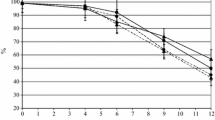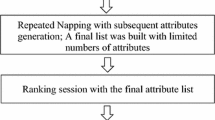Abstract
The purpose of this research was to evaluate the ability of four strains of Saccharomyces cerevisiae endowed with β-glucosidase activity to improve the Trebbiano wine aroma profiles and quality. In particular, the strain effects on fermentation kinetics, sugar and acid concentrations, volatile aroma compound profiles, colour, and catechins parameters were evaluated. The four strains of S. cerevisiae were tested in comparison with a commercial strain. The results showed that the four wild strains had high fermentation rates associated with an efficient conversion of grape sugars to alcohol. In addition, each strain imparted specific features to the wine. In fact, significant differences in relation to the inoculated strain were observed mainly in residual sugar content, succinic and tartaric acid concentrations, and volatile aroma compound profiles as esters, higher alcohols, and terpenes. In particular, the products obtained with S. cerevisiae BV12 and BV14 were characterized by lowest residual sugar contents. Moreover, BV14 and AS15 produced the wines with the highest concentrations of succinic and tartaric acids. Also, the wine obtained with the strains AS11 and AS15 showed high concentrations of monoterpenes and particularly linalool and geraniol having a strong sensorial impact. Furthermore, the wine obtained with the strain AS11 showed a minor decrease in colour intensity, probably due to the highest content of total SO2. These results outlined the importance of the strain selection, tailor made based on the wine feature and the wine making process adopted.


Similar content being viewed by others
References
Antonelli A, Arfelli G, Masino F, Sartini E (2010) Comparison of traditional and reductive winemaking: influence on some fixed components and sensorial characteristics. Eur Food Res Technol 231:85–91
Bautista-Ortin AB, Romero-Cascales I, Fernández-Fernández JI, López-Roca JM, Gómez-Plaza E (2007) Influence of the yeast strain on Monastrell wine colour. Innov Food Sci Emerg Technol 8:322–328
Berthels NJ, Cordero Otero RR, Bauer FF, Thevelein JM, Pretorius IS (2004) Discrepancy in glucose and fructose utilization during fermentation by Saccharomyces cerevisiae wine yeast strains. FEMS Yeast Res 4:683–689
Caridi A (2007) New perspectives in safety and quality enhancement of wine through selection of yeasts based on the parietal adsorption activity. Int J Food Microbiol 120:167–172
Castellari M, Versari A, Spinabelli U, Galassi S, Amati A (2000) An improved HPLC method for the analysis of organic acids, carbohydrates and alcohols in grape musts and wines. J Liq Chromatogr Related Technol 23:2047–2056
EC (2000) Community reference methods for the analysis of spirits drinks. Official Journal of the European Community (Reg EC No 2870/00. 19 Dec, Brussels).
Escot S, Feuillat M, Dulau L, Charpentier C (2001) Release of polysaccharides by yeasts and the influence of released polysaccharides on color stability and wine astringency. Aust J Grape Wine R 7:153–159
Glories Y (1984) La coleur des vins rouges: 11 partie. Les equilibres des anthocyanes et des tanins. Connaissance de la Vigne et du Vin 18:195–217
Henschke PA (1997) Yeast sugar metabolism: biochemistry, genetics, biotechnology and applications. In: Zimmermann FK, Entian KD (eds) Wine yeast. Technomic, Lancaster, pp 527–560
Hernandez LF, Espinosa JC, Fernandez-Gonzalez M, Briones A (2003) ß-Glucosidase activity in a Saccharomyces cerevisiae wine strain. Int J Food Microbiol 80:171–176
Ivanova V, Stefova M, Chinnici F (2010) Determination of the polyphenol contents in macedonian grapes and wines by standardize spectrophotometric methods. J Serbian Chem Soc 75:45–59
Li H, Tao YS, Wang H, Li Z (2008) Impact odorants of Chardonnay dry white wine from Changli County (China). Eur Food Res Technol 227:287–292
Lowinsohn D, Bertotti M (2001) Determination of sulphite in wine by coulometric titration. Food Addit Contam 18:773–777
Maicas S, Mateo JJ (2005) Hydrolysis of terpenyl glycosides in grape juice and other fruit juices: a review. Appl Microb Biotechnol 67:322–335
Manzanares P, Orejas M, Ibanez E, Valles S, Ramon D (2000) Purification and characterization of an L-rhamnosidase from Aspergillus nidulans. Lett Appl Microbiol 31:198–202
Mateo JJ, Jimenez M (2000) Monoterpenes in grape juice and wines: review. J Chromatog A 881:557–567
Morata A, Gómez-Cordovés MC, Suberviola L, Bartolomé B, Colomo B, Suárez JA (2003) Adsorption of anthocyanins by yeast cell walls during the fermentation of red wines. J Agr Food Chem 51:4084–4088
Ribereau-Gayon P, Glories Y, Maujean A, Dubourdieu D (2006) The chemistry of wine stabilization and treatments. In: handbook of enology, vol 2, 2nd eds. Wiley, Chichester, pp 205–227
Rodrıguez ME, Loopes CA, Van Broock M, Vallees S, Ramon D, Caballero AC (2004) Screening and typing of patagonian wine yeasts for glycosidase activities. J Appl Microbiol 96:89–95
Rosi I, Gheri A, Domizio P, Fia G (2000) Production de macromolecules pariétales de Saccharomyces cerevisiae au cours de la fermentation et leur influence sur la fermentation malolactique. Revue des Oenologues 94:18–20
Salomon JM, Fornairon-Bonnefond C, Mazauric JP (2002) Interactions between wine lees and polyphenols: influence on oxygen consumption capacity during simulation of wine aging. J Food Sci 67:1604–1609
Sanchez-Torres P, Gonzalez-Candelas L, Ramon D (1998) Heterologous expression of a Candida molischiana anthocyanin-bglucosidase in a wine yeast strain. J Agr Food Chem 46:354–360
Spagna G, Barbagallo RN, Pifferi PG (2000) Fining treatments of white wines by means of polymeric adjuvants for their stabilization against browning. J Agric Food Chem 48:4619–4627
Todaro A, Palmeri R, Barbagallo RN, Pifferi PG, Spagna G (2008) Increase of trans-resveratrol in typical Sicilian wine using β-glucosidase from various sources. Food Chem 107:1570–1575
Tosi E, Azzolini M, Guzzo F, Zapparoli G (2009) Evidence of different fermentation behaviours of two indigenous strains of Saccharomyces cerevisiae and Saccharomyces uvarum isolated from Amarone wine. J Appl Microbiol 107:210–221
Ubeda Iranzo JF, Briones Perez AI, Izquierdo Canas PM (1998) Study of the oenological characteristics and enzymatic activities of wine yeasts. Food Microbiol 15:399–406
Ugliano M, Henschke PA (2009) Yeast and wine flavour. In: Moreno-Arribas MV, Polo C (eds) Wine chemistry and biochemistry. Springer, Chapter 8D, New York, pp 313–392
Vernocchi P, Ndagijmana M, Serrazanetti DI, Chaves Lopez C, Fabiani A, Gardini F, Guerzoni ME, Lanciotti R (2011) Use of Saccharomyces cerevisiae strains endowed with β-glucosidase activity for the production of Sangiovese wine. World J Microb Biot 27:1423–1433
Author information
Authors and Affiliations
Corresponding author
Rights and permissions
About this article
Cite this article
Vernocchi, P., Patrignani, F., Ndagijimana, M. et al. Trebbiano wine produced by using Saccharomyces cerevisiae strains endowed with β-glucosidase activity. Ann Microbiol 65, 1565–1571 (2015). https://doi.org/10.1007/s13213-014-0995-8
Received:
Accepted:
Published:
Issue Date:
DOI: https://doi.org/10.1007/s13213-014-0995-8




